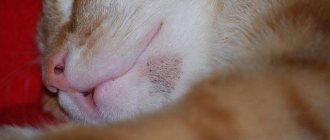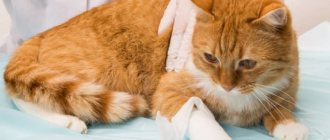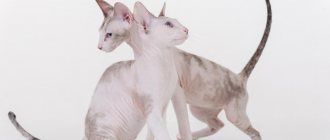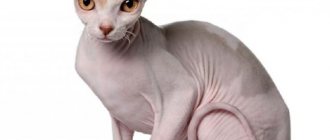Acne in cats is a skin condition that appears as rashes. The most interesting thing is that this disease also occurs in humans. Unlike humans, acne in cats is not caused by puberty. In life, this disease has other names, such as “blackheads” and “acne.”
In simple terms, acne is an inflammation of the sebaceous glands. For the most part, the Don Sphynx and the Persian breed suffer from this disease.
Due to the lack of fur, Don Sphynxes have skin that is more exposed to the external environment. Therefore, the likelihood of irritation throughout the body increases. And in the Persian breed, due to the folds on the muzzle, food accumulates near the oral cavity. If these residues are not removed in time, the pet may become inflamed.
Causes of acne in cats
Acne usually appears when the sebaceous glands malfunction. The process is based on the exfoliation of dead cells and secretions secreted by gland cells. For this reason, the ducts become clogged, due to peeling and secretion, the skin microflora deteriorates and stops multiplying, and as a result, irritation occurs. Experts have not yet fully figured out why this happens.
There can be quite a lot of factors for the appearance of “black dots”. The reasons are exogenous (external) and endogenous (internal). If this happens, you should think about and reconsider caring for your pet.
Endogenous factors of acne are considered:
- hormonal disbalance;
- metabolic disease;
- allergies to objects, food;
- liver problems;
- individual skin characteristics;
- the appearance of parasites in the body.
Exogenous factors are considered:
- dirty food bowls - the animal gets its face dirty, and food debris blocks the sebaceous ducts;
- When sick or old, cats begin to wash themselves poorly or stop taking care of themselves altogether;
- wounds and scratches can cause irritability;
- overvoltage;
- poor nutrition.
The main factors include:
- Incorrect feeding. The pet must receive all the necessary food for the normal functioning of the body. Malnutrition and overfeeding should be avoided.
- Infection. If an animal has bacterial or fungal infections, this can have a bad effect on the body, including the skin.
- Paraanal glands. This is also considered an important factor, since they directly affect the normal functioning of the skin. And even if your pet’s anal glands are fine, it’s still better to play it safe and have them checked.
- Bowl for food. First of all, you need to pay attention to what kind of dishes your cat eats from, what material the bowls are made of, and what sanitary condition they are in.
Important! Spayed and neutered cats are least susceptible to this disease. This is due to changes in the pet’s hormonal levels after surgery, which is not prone to rapid changes in sexual activity.
Description of possible causes
First of all, you need to pay attention that the characteristics of the breed can also play a special role. For example, Bengal cats may have peeling skin on their nose from the first months of life. As you grow older, this symptom may disappear without a trace. Great importance is paid to the accompanying symptoms of the part of the body on which peeling appears. Here is a list of the most common diseases that need to be excluded first:
Demodecosis. It is most common in adults over the age of 10 years. Serious internal diseases (chronic renal failure) and hormonal fluctuations (estrus, pregnancy) can provoke the activity of this type of tick. Often demodicosis is diagnosed after long-term use of antibiotics and operations. In other words, something must affect the immune system for the mite to begin to pathologically multiply on the skin. In this case, large bald patches may appear, inside of which there is severe peeling. There is no itching. If the process is not complicated by a secondary infection. In most cases, eliminating the root cause that provoked the activity of demodex leads to complete recovery.- Lichen. A real disaster for owners who have several animals living in their house. Ringworm is considered a highly contagious type of fungus that can even spread to humans. It is most common in cats living outdoors or in a cattery. The distinctive signs of lichen are large bald patches, inside of which the skin peels and turns red. The pet pays special attention to the affected areas, trying to lick, bite or chew them out. This causes large wounds and scratches. A secondary infection often occurs. The localization of lesions is varied, ranging from the tips of the ears to the paws. Ringworm can be confused with an allergy or
pyoderma. To confirm an accurate diagnosis, a series of studies are carried out (cytology, microscopy and culture), on the basis of which the fungal culture is determined. Most often these are dermatophytes and trichophytons, less often yeast fungi. Terbinafine and Imaverol are used as treatment. Remember that lichen can constantly recur if not treated correctly. - Peculiarity of the breed. Hairless cats have an innate predisposition to the appearance of comedones. They are formed due to excess sebum that accumulates in the hair follicle. In Sphynxes, the appearance of comedones is always accompanied by severe peeling of the skin and redness. Itching is observed only if the process is complicated by a bacterial infection or furunculosis. In severe cases, glucocorticosteroids may be used.
- Allergy. The most common cause of flaking and white dandruff in cats' fur. The affected areas also become inflamed, swollen and very itchy. Due to scratching, the process may be complicated by secondary infection. Against the background of allergies, demodicosis can also become more active, which is described in detail above. Most often, ornamental breeds suffer, in which the slightest change in diet can have a strong impact on the skin. If there is a hereditary predisposition to allergies (often found in Persians, Maine Coons, Bobtails), then even a small piece of flour or sweet food can provoke a strong reaction. Therefore, owners of such breeds
you need to carefully watch that no one feeds their pet or that the animal itself does not steal something from the table. Since the treatment is long-term, with constant relapses, which bring significant discomfort to the cat. If it is not possible to identify a potential allergen, then treatment will be symptomatic. In this case, the owner must be informed that even the complete disappearance of symptoms is not considered recovery. Since the slightest contact with an allergen can provoke an even greater reaction. - Cheyletiellosis. Another type of mite that can cause flaking in cats. Only unlike demodicosis, cheyletiella can cause discomfort to the owners (bite them). At the same time, this type of tick does not reproduce in humans, it only bites. A pet, in turn, can only be a carrier. Therefore, it is recommended to treat the cat with drops (on the withers) of Stronghold or Frontline combo 2 times every 3 weeks. If symptoms persist, then the participation of a dermatologist will be required to conduct a microscopic examination of scrapings taken from the animal's skin (scales, peeling and hair). This test will confirm or rule out the presence of a tick.
Symptoms
Often, the cat's owner does not even realize that his pet has acne until he notices black dots in the chin area or on another part of the body. The animal may feel fine for a long time until severe itching appears. Males are known to suffer more often due to the effects of testosterone on the base of the tail.
There are signs by which it is easy to determine the initial stage of acne:
- at the site of future inflammation, the coat becomes shiny;
- a yellowish color is noticeable;
- Black dots appear on the skin, which are most often confused with ordinary dirt or flea eggs.
The main locations of acne on the body in cats:
- chin;
- lip;
- muzzle;
- back;
- base of tail;
- near the eyebrows;
- near the ears;
- in the corners of the mouth;
- on the stomach.
Four stages of the disease :
- skin redness;
- acne formation;
- the pimple matures, pus forms at the top, which breaks out after a while;
- if the process goes smoothly, the wound heals and the skin gradually recovers.
Important! The process can worsen when, with a weakened immune system, pus infects a healthy area, which is considered extremely dangerous to health.
With complications, acne develops into purulent skin lesions. Swelling appears and gradually increases.
How does a cat's behavior change?
- the animal behaves restlessly;
- frequently licks the affected area;
- feels severe discomfort, unbearable itching and itches all the time.
How to treat?
To get rid of pimples, you need to treat them with peroxide and lubricate the acne 2 or 3 times a day, around them with sea buckthorn oil. The veterinarian can prescribe "Bioseptonex" or "Septifort", but they must be applied to the cat's body carefully, if an allergy occurs, the skin at the application sites will turn black.
Sphynx cats tolerate Terramycin or Pfizer well. The pimples may be too deep and not go away under the influence of these medications, then you need to take your pet to an appointment with a veterinarian. Perhaps the diet is not suitable for the cat and needs to be changed.
Acne treatment
Treatment of this disease in cats at home is that the first step is to cleanse the skin of excess secretions and stop the appearance of acne.
The algorithm of actions is as follows:
- The hair in the damaged area must be shaved.
- The affected area is treated several times a day with a special solution (peroxide, chlorhexidine).
- To remove the top layer of epithelium, this can be done using salicylic acid.
If a cat has an infectious disease, then treatment without antibiotics is inevitable. In order to know which drugs will be needed, you need to be tested in a specialized laboratory, the study will show a drug sensitivity test and determine the bacterial culture.
Important! Tests must be taken to determine the presence of infection in the affected area, since antibiotics cannot be taken for a fungal infection.
What rules should you follow:
- pimples should not be squeezed out (the pus should come out on its own);
- the damaged area must be treated carefully, pointwise, so that the skin does not dry out;
- make sure that the animal does not scratch itself;
- You can’t always use drugs containing alcohol, this provokes inflamed acne;
- Apply a thin layer of special creams so that air can penetrate (this is necessary for healing).
Important! If pimples appear very often, the cause may be in the pet’s body. In all likelihood, it will be related to the intestines or liver.
To prevent recurrence of the disease, it is better to replace plastic dishes for your pet with higher quality ones made of stainless steel or ceramics, also change the litter for the tray and bathe the cat using professional shampoos.
Antiseborrheic shampoos and tar soap
Products such as antiseborrheic shampoo and tar soap do an excellent job of treating the skin. The cleaned area is washed with special soap or shampoo. The product is left on the skin for five minutes and then, with great care, wipe the skin with a cotton swab until dry.
Preparations for acupressure
The disease goes away faster if salicylic alcohol or ointment is applied to the skin, this helps soften the skin. To neutralize the area you will need hydrogen peroxide. Iodine is used to cauterize the surface of the epithelium. Calendula tincture also helps a lot. A gauze bandage soaked in tincture is applied to the affected area, and in the near future a good result will not be long in coming.
To make pimples go away faster, use solutions of chlorophyllipt and clotrimazole 1%. In treatment, effective drugs such as Percutan, Chlorhexidine or Miramistin are used to safely treat the irritated area of skin before visiting a doctor.
It is important to ensure that the cat does not lick the medications.
Course of treatment with corticosteroids
Acne can lead to very severe inflammation and in this case the doctor will prescribe a course of treatment with corticosteroids, usually prednisolone.
Folk remedies
An equally common way to treat acne are decoctions:
- Choose any glass container, add 20 g of chamomile and calendula. Pour hot water and bring to a boil over low heat. The resulting broth is filtered. Grind two tablets of the drug, add approximately 15 ml of decoction. It is enough to make a mask every other day, leave for 20 minutes. Use a towel to clean it all up.
- Cut the pumpkin into small pieces. These pieces are used to wipe acne. The skin should be treated with an antiseptic and pieces of pumpkin should be placed on the affected area for 5 minutes.
- Add 20 g of yarrow to a glass of water (preferably dried). Pour boiling water over the flowers, cover with a lid and let steep for an hour. This is an excellent substitute for lotion; use a cotton swab to wipe the irritated area in the morning and evening.
- Celandine copes well with inflammation. Add a spoonful of celandine to a glass of water and bring to a boil in a water bath. Boil for 5-7 minutes, then let the resulting liquid cool. Treat acne twice a day, warming the broth to 40 degrees.
How to prevent the development of the disease
Preventing acne in your pet is:
- careful attention to the health of the cat;
- compliance with hygiene measures, especially in acne-prone breeds: bathe in a timely manner;
- wipe your face after eating;
- feed/water only from clean dishes;
- do not use plastic bowls;
Disease prevention
Every effort can be made to reduce the likelihood of acne in cats. To do this you need to adhere to certain rules. Do not try to give your pet very greasy or fatty foods. Human food can harm your pet and contribute to various diseases.
You should always wash dishes from which your cat drinks or eats. Replace plastic bowls with metal or glass ones. This will prevent bacteria from multiplying. Monitors the cat's fur and well-being, and keeps the house clean. It is advisable to visit a veterinarian once every six months to make sure your cat is healthy.
Sphynx skin care: acne and pimples
The formation of acne and pimples is typical for Sphynx cats. As a rule, they form on the tail, chin and belly of the animal. The reasons for their formation and treatment are the same as for all other cats. As a preventive measure, it is recommended to periodically wipe the areas where acne is most likely to appear - with micellar water, chlorhexidine or a special lotion (the latter should be washed off with warm water). Castration of the animal can also reduce the formation of acne, since hormonal surges contribute to the occurrence of skin problems.
Sphinx tail
If a biopsy of the affected skin areas has not yet been performed, now is the time to do it.
If the role of nutritional factors in the origin of allergic skin itching is not confirmed, the main suspicions lean towards atopic dermatitis, in which special baths and medications are used to combat its manifestations.
In any case, chronic skin itching is extremely disturbing to the Canadian Sphynx and providing him with symptomatic help, independent of the causes, is certainly necessary.
© 1999 adaptation and translation: Dr. Vadim Brokhin ( [email protected] ), materials from the Marvista clinic were used.
come back









